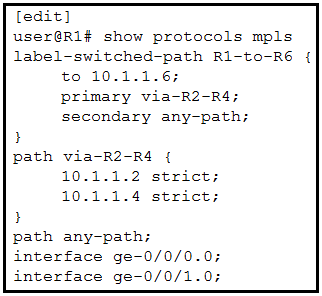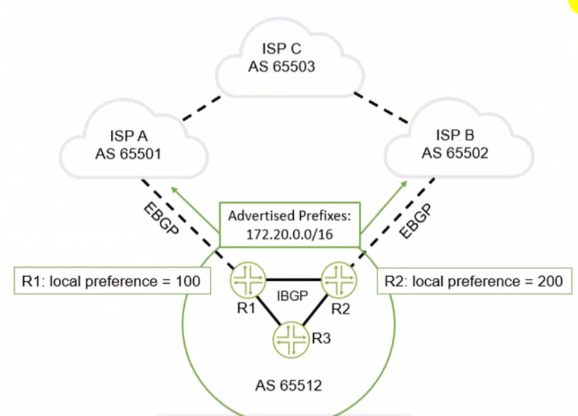Juniper JN0-363 Service Provider Routing and Switching, Specialist JNCIS-SP Exam Practice Test
Click the Exhibit button.

All devices in the network are configured correctly and the path requirements are valid.
Referring to the exhibit, which two statements are correct? (Choose two.)
Answer : A, C
According to the exhibit, the primary LSP is configured with a strict path via R2 to R4. Since the configuration shows valid next-hops and there is no indication of any issues, the primary LSP will be signaled and its state will be up. The secondary LSP with any-path is also configured and will be signaled as a backup; therefore, its state will be up as well, ready to take over if the primary fails. Reference::
MPLS LSP Configuration, Juniper Networks Documentation
Configuring Primary and Secondary LSPs, Juniper Networks Documentation
Click the Exhibit button.

Referring to the exhibit, you have an established RSVP LSP between R1 and R4 when you experience a link failure between R2 and R3.
Which two statements are correct? (Choose two.)
Answer : A, D
Upon a link failure in an RSVP-signaled LSP, the router upstream of the failure (R2) sends a PathTear message upstream to the ingress router (R1), and the router downstream of the failure (R3) sends a ResvTear message downstream to the egress router (R4). These messages signal the failure and initiate tear down of the LSP state in the respective directions. Reference::
RSVP-TE Overview, Juniper Networks Documentation
Understanding RSVP Signal Failures, Juniper Networks Documentation
You are implementing traffic engineering in your MPLS network. You must ensure that the MPLS routes are used to traverse your network. Your solution should not affect IGP routes in your route tables.
In this scenario, which traffic engineering setting will accomplish this behavior?
Answer : B
To ensure that MPLS traffic-engineered routes are used without affecting IGP routes in the route tables, the mpls-forwarding traffic engineering setting should be used. This setting allows MPLS to influence forwarding without changing the IGP route selection. Reference::
MPLS Traffic Engineering, Juniper Networks Documentation
Traffic Engineering and LSP Optimization, Juniper Networks Documentation
You want to share routes between two routing instances that you have configured?
What are two ways to accomplish this task? (Choose two.)
Answer : B, D
static route with a next-hop of next-table pointing to the appropriate routing table which contains more accurate information rib-groups to mirror routing information from one route-table to another. However, in many cases, in order to make this work, interface-routes also need to be mirrored. RIB Group policy can be used to constrain the routing information instance-import and instance-export statements configured within the individual routing-instances to leak routes from one table to another. Again, policy can be used here to constrain the routing information. This method is more straightforward than the rib-group method A final approach is to use physical interfaces or logical-tunnels to stitch routing-instances and use a routing protocol or static routes across this connection between the two routing-instances.
To share routes between two routing instances on a Junos device, you can configure an instance import policy in one or both instances to import routes from the other instance. Alternatively, a RIB (Routing Information Base) group can be used to share routes between instances. Reference::
Routing Instances Overview, Juniper Networks Documentation
RIB Groups Configuration Guide, Juniper Networks Documentation
Which two interface types are used as tunnel endpoints? (Choose two.)
Answer : B, D
tunnel-end-point name {
ipv4 {
source-address 10.255.1.1;
destination-address 10.255.2.0/25;
}
gre {
key 9;
}
}
The ip and gr interface types are used as endpoints for various tunneling protocols. ip is a generic term that can refer to any IP-based tunnel, while gr specifically refers to Generic Routing Encapsulation (GRE) tunnel interfaces in Junos.
Juniper Networks documentation on Interface Types: Interface Types and Their Default Properties
Which two statements ate correct about the community BGP attribute on a Junos device? (Choose two.)
Answer : C, D
The community attribute in BGP is an optional transitive attribute. It is not mandatory for BGP operations, but when it is present, it should be passed unchanged to other BGP peers unless explicitly modified by a routing policy. The community attribute is used to group destinations in a certain way, often to apply routing policies to those destinations collectively.
Juniper Networks documentation on BGP communities: BGP Communities Overview
Exhibit

You are advertising a summary route that represents your local network (172.20.0.0716) to both ISP A and ISPB. You want to influence all traffic sent to you from ISP C to go through R2.
How would you accomplish this task?
Answer : C
To influence ISP C to prefer the path through R2 for the 172.20.0.0/16 network, R2 should make its path less preferable to ISP B by prepending its AS number multiple times. This makes the path through R2 appear longer and less desirable to ISP C, which would receive these updates from ISP B. AS path length is a well-known attribute in BGP and is used to determine the best path; paths with a longer AS path are considered less preferable.
Juniper Networks documentation on BGP: BGP Path Selection and Configuration